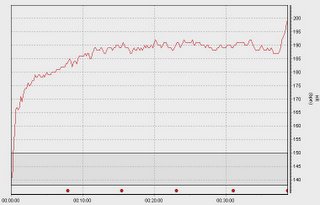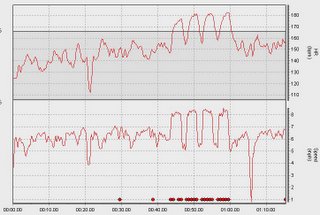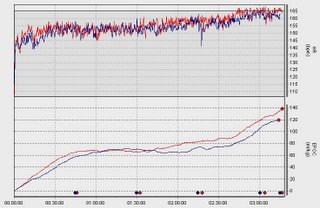I like to learn and find that writing down what I think I've learned is the quickest way to figure out that I really didn't know what I was talking about. If I write it down and it still looks right, then I figure it probably is. If I put it in a blog, maybe someone will check my work. Maybe they'll even point me in the right direction. OK, I'm blogging. Here we go.
I'm interested in a ridiculous number of things, but I'll start with running. I took up running consistently a little over a year ago (my 2005 New Year's resolution). I started running to get in better shape, but like everything with me, it has become an intellectual exercise -- one of many learning projects. With running, however, I'm the guinea pig in the experiment. In this post, I'm basically rationalizing my plan for marathon redemption. I'll see if it still makes sense after I write it down.
Marathon redemption? I ran my first marathon last fall, and while I finished, I was disappointed in my time (4:50) since I believe it is less than I was capable of. I haven't run that many races, but here are my times.
- 10 miles, 1:24:49, 4/05
- 20 miles, 3:06:05, 9/05
- marathon, 4:49:21, 10/05
- 10K, 50:13, 11/05
- 5 miles, 38:39, 11/05
Based on my previous race times, I'd have expected something in the 4:10 - 4:15 range. This is conservative, allowing for greater than normal fall off with distance. The popular
McMillan running calculator predicts a 3:57:33 given my 10 mile pace, which I ran after having run for only four months. The 20-mile time would predict 4:07:50, but I didn't run that all out because I was training for the marathon. (I layed back the first half and ran the second half 5 minutes faster.) Even assuming the 20-mile time was the best I could do and the falloff with distance would get worse with the marathon that still only gets me to maybe 4:10 - 4:15. 4:50 is hard to understand.
So what actually happened in the marathon? Did I start out too fast and crash? I don't think so. I started slow and got slower. Then I hit the wall. Here are the splits: 2-21:51.20 (missed mile 1 marker), 3-9:54.06, 4-9:39.76, 5-10:14.78, 6-10:01.25, 7-10:47.81, 8-10:14.15, 9-10:00.25, 10-10:15.26, 12-20:02.24 (missed mile 11 marker), 13-10:16.00, 14-9:45.00, 15-10:39.31, 16-10:08.00, 17-10:25.94, 18-11:45.24, 19-11:02.27, 20-12:09.24, 21-12:24.95, 22-12:47.96, 23-13:19.97, 24-13:29.84, 25-13:50.03, 26-11.29:07, 26.2-2:54.13
I could tell my heart rate was high early on and running was harder than normal from the beginning (in the 20-miler I felt like I was coasting). I slowed down and tried to run at my training pace (what you're supposed to do for your first marathon anyway). That lasted until mile 17 when I succumbed to the urge to stop and started mixing in walk breaks.
What went wrong? Some theories:
- I don't think I was feeling well. The day before I felt like I was sick and on my 3 mile jog, I had a heart rate was higher than expected. I attributed it to nerves, but maybe I was under the weather.
- I have to say that I quit to some extent after I realized I wasn't going to get a time near what I expected. I probably could have gutted out the last 9 miles better and saved maybe 10 minutes.
- I might have undertrained after the 20-miler (5 weeks prior to the race). I started wearing a heart rate monitor (didn't wear it during the race though) and doing all my runs at an easy pace after that. (This theory, however, is somewhat contradicted by the 10K and 5-miler I ran during the next month which are my best times. I didn't do any extra training for them, since I was recovering and running low, easy mileage.)
- I screwed up my last 20 mile training run (3 weeks prior). I ran the day after returning from a west coast trip (jet lagged) in an absolute downpour on a puddle-filled trail. My shoes literally weighed 3 pounds and it took 4 hours and 14 minutes as I also tried to keep my heart rate low. In retrospect I should have bagged it early on and ran the next day.
- My training schedule really wasn't enough to do more than get me through. I did the Bob Glover "casual marathoner" schedule (which peaks at 40 miles and has long runs every other week) and did all my miles at an easy pace. From that I probably couldn't expect to do much more than get through the marathon. To be clear, I think Coach Glover is absolutely fantastic, his Runner's Handbook is great for new runners, and following his program is probably what kept me injury free. I probably just shouldn't have had any time expectation.
- My nutrition was poor. I ate too much junk the last week especially. Carbo-loading shouldn't mean candy and soda.
The plan for redemption started with signing up for a March marathon and a lot of reading. I checked a number of books out of the library, read them, and found what seemed to be sound, scientifically-supported advice. Jack Daniels, Pete Pfitzinger, and Tim Noakes seemed to all be saying basically the same thing and offered evidence to back it up.
I decided to use Pfitzinger's
Advanced Marathoning because it has explicit schedules. Since my time was somewhat short until my chosen marathon, I chose the 12-week, less than 55mpw program. I followed his 5 week recovery schedule after the previously mentioned disaster marathon, held at 35mpw for a few weeks, and then started the 12 week schedule.

In my thirst for data, I bought a Suunto T6 heart rate monitor (HRM) that will let you store the data and download it to your computer. I also got the foot pod thingy for measuring distance. I wore it during the 5-miler and sprinted to the finish in order to try and ascertain my maximum heart rate. I started sprinting too late, however, (wasn't sure exactly where the finish line) and as you can see in this graph, my heart rate looks like it was still on the way up at 199 bpm when I crossed the finish line. I've been calling it 200 bpm to be conservative and make the math easy. I'd guess my real max is a little higher.
I've been using 50 bpm as my minimum heart rate. This is based on wearing the HRM while sitting in front of the computer and relaxing until I saw 49 bpm. I haven't really tried to check it when first waking up, so chances are it's a little lower, but I've been basing my effort on % max heart rate, so minimum heart rate doesn't really matter.
This wikipedia article explains the heart rate terms.
Pfitzinger prescribes the following heart rates for the various workouts:
- VO2max: 94-98 %MHR, 93-98 %HRR
- Lactate Threshold: 80-90 %MHR, 76-88 %HRR
- Long runs: 73-83 %MHR, 65-78 %HRR
- Recovery: <75%
For recovery runs, I set my HRM alarm to 150 bpm and follow it religiously. For long runs, which I do on Sundays, I set it to 155 for the first 5 or so miles and then set it to 160 bpm. I'll let it go to 166 bpm after 15 miles if I need to (which I always do) to keep pace. Initially I just set it to 160 from the beginning, but decided after I wasn't fully recovered for a Tuesday run that I would limit myself to 155 at the beginning, since it's possible to go to hard before you warm up otherwise. This seems to have worked well.
Pfitz also has general aerobic and medium long runs (MLR) in his schedule, which are really just shorter long runs. It has to be 17 or more for Pfitz to call it a long run. (For some reason I find using "medium long" to describe a 16 mile run a little insulting. Why am I OK with a 15 miler being "medium long?") For GA and MLR, I just set the alarm to 160.
I've tried doing the lactate threshold and VO2max (the single one I've done) by pace using my 5-mile run time and the McMillan calculator to find my 15K-Half Marathon and 5K paces. My route is very hilly though, so I've modified the lactate threshold pace some and kept an eye on the HRM. For the one 5K pace VO2max session I've done, I couldn't make myself go fast enough to either get into the heart rate zone or hit my predicted 5K pace. I ran about my 5 mile pace. I think my body just hasn't figured out how to go that fast yet.
The race is 5 weeks from tomorrow when I do my first 20 mile run of the schedule.
Today's training: 5 mi recovery on 3 mi neighborhood loop, 49:14, 144 bpm avg












